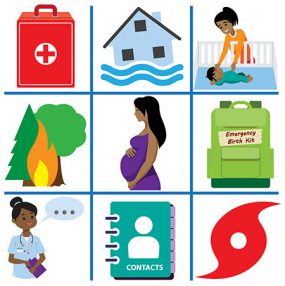Reproductive Health in Emergency Preparedness and Response
CDC’s Division of Reproductive Health (DRH) prepares for and responds to the needs of reproductive-aged women and infants before, during, and after public health emergencies. Working in settings where disasters have occurred and developing emergency care information for pregnant women and their health care providers are priority activities.

Understanding the Impact of Disasters on Reproductive Health
Disasters generally can be put into three categories:
- Natural disasters (e.g., hurricanes, tornadoes, earthquakes, wildfires, floods)
- Emerging or pandemic diseases (e.g., flu outbreak, Zika virus)
- Man-made disasters (e.g., terrorist attacks).
The United States has averaged over 60 major federally declared disasters annually in the past 10 years.1 Nearly 850,000 people in the United States are affected by natural disasters yearly. However, that number does not include those affected by man-made events or pandemic diseases.
Disasters disrupt lives, families, and communities. Disasters can affect access to medical and social services, increase stress, intensify physical work, and expand caregiving duties. This may affect access to medical services and health outcomes among women of reproductive age (15 to 44 years), especially pregnant and postpartum women and newborns. Pregnant women are classified as a population with special clinical needs in the Pandemic and All-Hazards Preparedness Reauthorization Act of 2013. Disasters can present unique challenges to pregnant women and potential exposures to the developing fetus during pregnancy can affect infants and children as they grow. Some exposures during pregnancy, like Zika virus infection, can cause birth defects in infants. Other possible impacts of public health emergencies during pregnancy include pregnancy loss, small size for gestational age, preterm birth, and other complications.2,3
References
- Federal Emergency Management Agency (FEMA). FEMA Disaster website. https://www.fema.gov/disasters/year?field_dv2_declaration_type_value=DR&=Apply. Accessed September 25, 2018
- Harville E, Xiong X, Buekens P. Disasters and perinatal health: a systematic review. Obstetrical and Gynecological Survey. 2011;54(11):713–728.
- Zotti M E, Williams A M, Robertson M, Horney J, Hsia J. Post-disaster reproductive health outcomes. Maternal and Child Health Journal. 2013;17(5):783–796.





















.jpg)












No hay comentarios:
Publicar un comentario